An attic insulation replacement or addition can save you money on your energy bills. The best way to save time, money, and possibly a trip to the chiropractor is to blow insulation with your hands rather than using an insulation-blowing machine.
With a machine, loose-fill insulation is usually blown in to replace old or add a few inches. A 100-foot (or more) hose runs from the machine to the attic, which is plugged in outside the house.
A person must feed the hopper in the machine where it is churned and fluffed while you handle the hose and spray the loose fill where you want it to go.
Unless broken up, bales of loose fill don’t cover much space, and they perform poorly if not broken up.
These machines are highly recommended if you’re working on a major project. But unfortunately, it will only leave you disappointed, disillusioned, and dusty.
There are usually free days of the rental when you purchase 20 bales or more at most home improvement stores that rent them.
Insulation Blower Definition
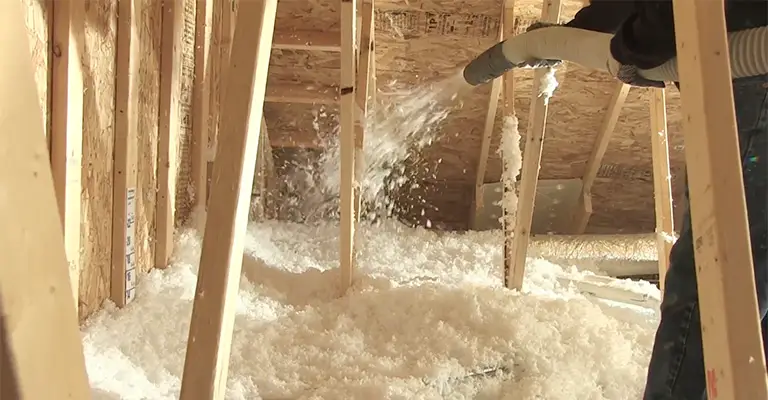
In these hard-to-reach areas, an insulation blower is located on the ground and outside the house.
An insulation blower machine has a hopper (for dumping loose insulation bags), an engine for driving the blower, and a hose that connects to it.
Attic joist cavities can be insulated by shaking them out by hand. Adding insulation to neglected areas on a small scale is done this way. Unfortunately, it’s not practical on a large scale, and the results are less than ideal.
With a blower, you can deliver the material more easily and consistently. In addition, the blower separates cellulose insulation from its bags since it is packed tightly in bags. This is a difficult task to accomplish by hand.
Is Loose-Fill Insulation Something You Can Do Yourself?
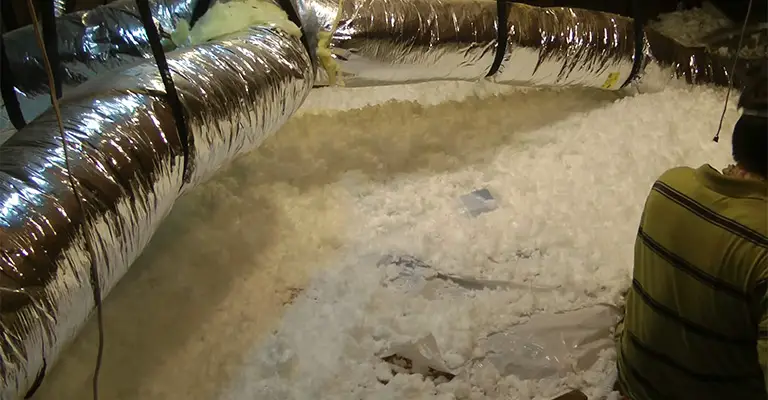
In the case of a small project, what should you do? Would it be better to top off a few places or replace insulation that has been removed from another project? During a leak, did the insulation get wet?
When you are sweating up in the attic, you don’t want to rent, haul home a machine weighing more than 100 pounds, and then promise to mow your neighbor’s lawn while he feeds it.
Rather than bringing bales home, why not just sprinkle them around yourself? That’s right. A loose-fill insulation installation can definitely be done without a machine.
This is a great way to remove a small section without dealing with the hassle of heavy machinery.
Does It Make A Difference Whether I Use A Blower Machine Or Not When Installing Cellulose Insulation?
The compression packaging of cellulose insulation requires a blowing machine to install it. Attempting to do this by hand is not recommended.
The rental of an equipment rental service or a big box home center may not be feasible with just a few bags, but you can certainly rent one.
Insulation of that type comes highly compressed, and when blown in, it will get separated and return to its original size. The insulation will have less insulation value if it is not decompressed since it will have no air space.
This results in more insulation material being used and more money being spent on less insulation capacity. Moreover, you won’t be able to disperse it into your wall without a blower.
Rather than pouring it in, blowing it in will spread it evenly, resulting in fewer gaps and less actual insulation.
Time is the next factor to consider. Again, manually inflating it will take longer than blowing it in. It must first be decompressed to its maximum size, lifted up to the hole, shoved in, and then manually dispersed.
Is it possible to do it without blowing it in? While this is true, it will be much more time-consuming, cost more in insulation, and will not provide as effective insulation, so you will lose more money over time.
Materials And Types Of Insulation
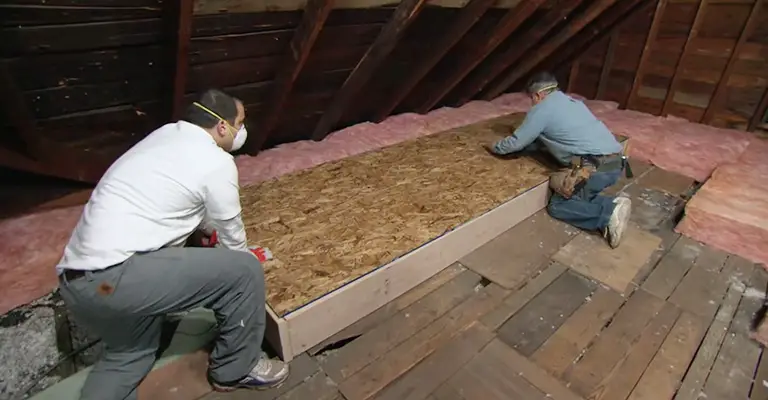
Batt and roll insulation and loose-fill insulation, sometimes called blown-in insulation, are the two types of insulation.
It is best to use loose fill (blown-in insulation) in tight spaces or if you already have an existing insulation layer in your attic. Unless you have a machine to handle loose-fill insulation, you’ll have to rent one.
Batt and roll insulation work well between joists and studs in wide-open spaces or crawl spaces. It is up to you to decide what material you will use. Heat flow resistance, or the R-value of the insulation, is the most critical consideration.
R-values indicate the level of resistance a product has. The required R-value depends on your region or climate. For example, R-values are typically higher in colder climates.
It packs tightly between the joists because it’s made of recycled paper that’s been treated to resist fire. Insulating your attic with fiberglass reduces the cost of your attic insulation. Furthermore, it has a fire-resistance rating.
Calculate your attic’s square footage by multiplying its length by its width. To determine the appropriate height for your project, refer to the back of the insulation package.
Renting An Insulation Blower
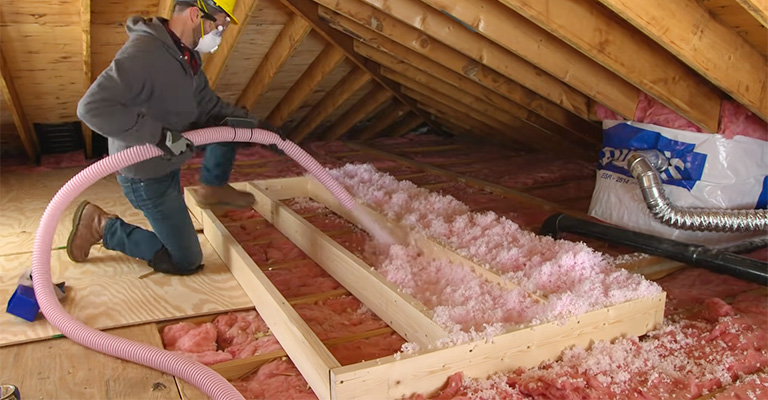
There are rental yards, and some home improvement stores that rent blow-in insulation blowers. You may have to purchase insulation as part of a blower rental package at home improvement stores.
Insulation purchases can be combined with a reduced blower rental rate. Blowing an entire attic should take one or two days as long as your materials are in order.
A week is the maximum time you can spend blowing insulation into an attic.
Insulation Work Safety Tips
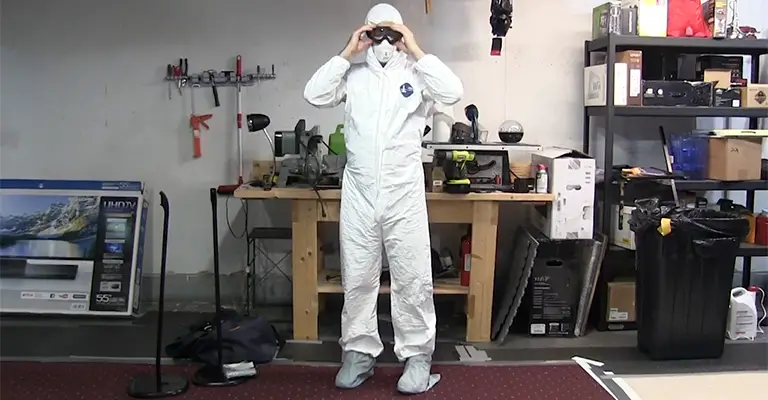
- You can even wear disposable coveralls or old long-sleeved shirts.
- If eye protection, gloves, and dust masks are recommended in the insulation instructions, check them.
- For comfort when working in crawlspaces or attics, wear knee pads. Especially around exposed roofing nails, hard hats are useful when working in tight spaces.
- Placing plywood over the joists is a great idea to create a work surface.
- Be careful when opening insulation packages and use them only when necessary. As soon as you open the packaging, the insulation expands rapidly.
- Insulate as much as you can without compressing it. R-values are affected by compressing materials.
- Be sure the insulation protects the pipes from cold air if you live in an area susceptible to frozen pipes.
- It is important to insulate ductwork where necessary to increase the efficiency of your heating and cooling system.
Buying Vs. Renting An Insulation Blower
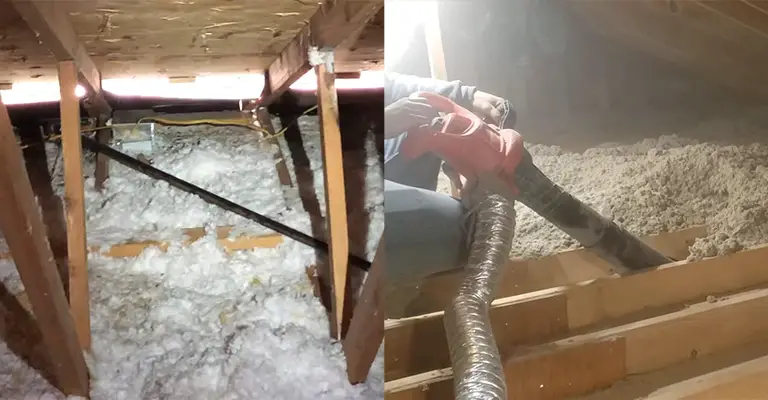
Which is better, renting or buying an insulation blower? Rental is the best option for most do-it-yourselfers. However, the decision is more complex for do-it-yourselfers or contractors who buy and resell houses.
There is a great deal of capacity and speed in top-quality blowers. For instance, it can push 82 to 135 bags of cellulose or fiberglass per hour with the Heat-Seal 5500.
The average size of contractor-grade blowers is 6 feet by 4 feet, weighing just over 1,500 pounds. Manufacturers such as Meyer and Heat-Seal, Inc. charge between $13,000 and $16,000 for their products.
There are, however, some insulation blowers that are relatively inexpensive. The insulation blowers made by Intec are more cost-effective than those made by other manufacturers, with lower volume and capacity specs.
A typical source of Intec Force 1 rentals is home centers. Weighting 50 pounds or 8 1/2 cubic feet, the Intec Force/2 has a capacity of 50 pounds. Capacity in feet.
The machine can produce over 2,000 pounds of cellulose insulation and 428 pounds of fiberglass insulation per hour.
About 300 pounds is the weight of this Intec blower with wheels, which is just what a truck can carry behind it. Gas-powered insulation blowers are usually larger, whereas two 20-amp household circuits power the Intec model.
Next-generation models, the Force/2, will cost between $7,000 and $8,000, while the Force/1 costs around $4,000.
Insulation Blower Rental Tips
It is possible to rent a blower from a rental facility that will deliver it. Most rental insulation blowers have hopper capacities of 4.25 cubic feet or 25 pounds and can blow 350 pounds of insulation an hour.
A truck is needed to transport this blower, which weighs 177 pounds. It is common for rental yards to charge higher rates for half-day rentals, with full-day rentals being the most economical.
Every week, the rental yard value increases dramatically, but it is nowhere near the rates found in home improvement stores. Make sure the blower is properly insulated. Unfortunately, there are times when the insulation on a blower isn’t interchangeable.
You can get a cheap insulation blower from a home center if you need it for one day or one week. Prepare everything before you pick up the blower or have it delivered.
Since the rental rates are high, you’ll save a lot of money if you spend as much time blowing as possible instead of preparing the space.
Final Words
Walls and other areas where minimal obstructions benefit from insulation in the form of long batts or rolls. Attics are another obstructed and sometimes a hard-to-access area where batts and rolls are often used.
Nevertheless, loose-fill insulation simplifies the process. The best insulation is loose-fill insulation blown in from a ground-based machine. A do-it-yourself option is also available for renting the machine.







